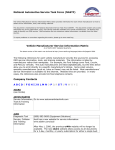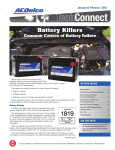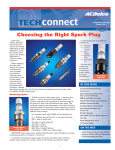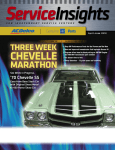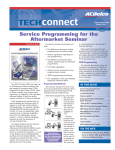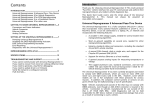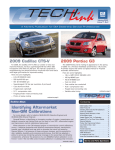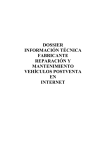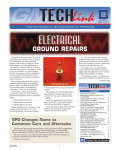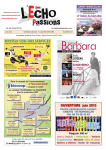Download Programming Tips and Tools
Transcript
March/April 2009 Volume 16, No. 2 (TS-PU-0007-09) Programming Tips and Tools enable J2534 pass-through programming and can work on Controller Area Network (CAN) data vehicles. GM The Tech 2 scan tool can be used for programming of non-CAN data vehicles. A Controller Area Network diagnostic interface (CANdi) module is needed for the Tech 2 to read CAN data. When to program or reflash an electronic control module is usually dictated by three conditions: directed by a technical service bulletin, installing a new control module, or a VIN search identifies a calibration update related to a customer concern. Performing a VIN search through the vehicle manufacturer’s website can save time and money when diagnosing a condition. No one wants to unnecessarily replace a part only to find out that there is a calibration that is needed to fix the condition. Many calibration releases from vehicle manufacturers no longer have associated technical bulletins. Since control module programming has become prevalent during repairs of all types, whether replacing a module or fixing a related condition, there are many things to take into consideration before, during and after programming. Service Programming Symbol There are a number of control modules that are capable of being programmed or require a service setup after service programming or installation, everything from the Engine Control Module and the Electronic Brake Control Module to the heated seat control module and the digital radio receiver. A Service Programming symbol is used in the Service Information to indicate components that may be programmed or require a service setup after installation or service. Click on the symbol in the Service Information to go to the Control Module Reference table. The table lists the appropriate programming and setup procedure for the control module. The GM Multiple Diagnostic Interface (MDI) is available for programming CAN data vehicles and offers faster programming than the Tech 2 while freeing up the scan tool for other diagnostic work. continued on page 3 IN THIS ISSUE Programming Tips and Tools . . . . . . . .1 Buyer Beware: Counterfeit Tools . . . .2 New ACDelco Advanced Cooling System Diagnosis Seminar . . . . . . . . .4 Checking Coolant Hoses . . . . . . . . . . .4 2009 TSS Scholarship Deadline Approaching . . . . . . . . . . . . . . . . . . . . . .5 ASE Testing . . . . . . . . . . . . . . . . . . . . . . .5 Controlling Diesel Emissions . . . . . . . .6 Tech Tips . . . . . . . . . . . . . . . . . . . . . . . . .7 The Service Programming symbol indicates a module is capable of programming or may need a service setup. The Service Programming symbol may also appear on the parts label of some components or be embossed on the part itself. Programming Tools Every manufacturer has developed their own programming tools that 1 Training Update . . . . . . . . . . . . . . . . . . .8 Show Off Your Ride . . . . . . . . . . . . . . . .8 ON THE WEB – www.acdelcotechconnect.com, click on the TechConnect Magazine link, or – Log on to the ACDelco LMS, click on the Resources link Buyer Beware: Counterfeit Tools Whatever you want, chances are you can find it on the web. But one of the chances you take when buying items through an online sale or an auction website is if they’re the real thing or fakes. ACDelco TechConnect is published bi-monthly and online for technicians of Total Service Support (TSS) and Key Fleet accounts to provide timely service information, increase knowledge and improve the performance of the service center. Publisher: Mike DeSander ACDelco E-mail / [email protected] GM and Bosch Diagnostics have discovered counterfeit Tech 2 scan tools and GM Controller Area Network diagnostic interface (CANdi) modules available to the aftermarket through online auction websites and other retail websites. Editor: Can you tell the difference? These tools appear to be very The top CANdi module is counterfeit. authentic from their exterior appearance. Everything is copied to closely resemble the real thing – from the cables and plastic cases to the brand logos and serial numbers. However, some of these counterfeit tools acquired by GM and Bosch Diagnostics have been found to be built with lower grade components and electronics or with used equipment from other diagnostic tools. As a result, some of the counterfeit tools will not work right from the start, may fail quickly or will run extremely slow. Technical Editors: Mark Spencer E-mail / [email protected] Jim Horner E-mail / [email protected] Production Manager: Marie Meredith Desktop Publishing: 5by5 Design E-mail / [email protected] In some cases, there are some slight physical clues that identify a counterfeit tool. Some fake CANdi modules have the same serial number on each module. Real CANdi modules will have a different serial module on each one. The LED on the top of a counterfeit CANdi module may be green. Real CANdi modules have a clear LED that glows green. Mike Militello ACDelco E-mail / [email protected] Write to: * An authentic CANdi module has a clear LED that glows green (A), not a green LED (B). Another clue on counterfeit modules may be the lack of a printed identifier number on the cable. Plus, the cable connectors of some counterfeit modules have brass inserts. The real modules use aluminum inserts. Scan tools and diagnostic tools such as the Tech 2 and CANdi module are large investments for many service centers. For buyers to ensure that they are getting the real tool, and the tech An authentic CANdi module uses support and warranty protection (authenaluminum inserts on the cable (A), not brass (B). tic Tech 2 scan tools and CANdi modules include a two-year warranty) that comes with it, purchases should be made from a well known source such as Bosch Diagnostics or OTC Tools. The bottom line may be that if the online deal for diagnostic and scan tools seems too good to be true, it probably is. – Thanks to Bob Stewart and Mike Waszczenko 2 ACDelco TechConnect P.O. Box 500 Troy, MI 48007-0500 : On the Web: To read and search recent issues of TechConnect online: – www.acdelcotechconnect.com, click on the TechConnect Magazine link, or – Log on to the ACDelco LMS, click on the Resources link ACDelco service tips are intended for use by professional technicians, not a “do-it-yourselfer.” They are written to inform those technicians of conditions that may occur on some vehicles, or to provide information that could assist in the proper service of a vehicle. Properly trained technicians have the equipment, tools, safety instructions and knowhow to do a job properly and safely. If a condition is described, it cannot be assumed that the information applies to all vehicles or that all vehicles will have that condition. All materials and programs described in this magazine are subject to change. Submission of materials implies the right to edit and publish. Inclusion in the publication is not necessarily an endorsement of the individual or the company. TechConnect is published for ACDelco by Sandy Corporation, Troy, MI. ©2009 ACDelco. All rights reserved. Programming Tips and Tools continued from page 1 Chrysler The DRBIII supports vehicle programming but does not work on CAN data vehicles. The StarSCAN works on Chrysler’s CAN data vehicles. The StarMOBILE adds wireless support, a custom data recorder, and pass-through diagnostics, freeing up the StarSCAN for more extensive diagnostic tasks. Ford The New Generation Star (NGS) Tester combined with the NGS Web Flash Kit provides the ability to download Ford calibration files and reprogram modules. Integrated Diagnostic Software and the Vehicle Communication Module are used to interface with standard computer platforms (PCs, laptops) on CAN data vehicles. Toyota The Mastertech scan tool can be used on non-CAN data vehicles. The TIS techstream offers full support and reprogramming for current CAN data Toyota/Scion/Lexus vehicles. For more information about scan tools and other programming tools available from vehicle manufacturers, refer to the following websites. Reputable aftermarket tool manufacturers, such as EASE Diagnostics, Snap-On Tools, SPX/OTC, and Bosch/ Vetronix, also offer various scan tools and pass-through programming tools. Proper Programming Before programming a control module, there are several important practices to follow to ensure that successful programming occurs. Vehicle system voltage – The vehicle’s battery voltage should be greater than 12 volts but less than 16 volts. The battery should be charged before a programming event. A battery charger should NOT be connected to the battery during programming unless it is a Midtronics PSC charger validated for use during programming. Also turn off or disable any system or accessories that may put a load on the battery, such as engine cooling fans, the radio, Daytime Running Lamps, etc. Maintain battery voltage during programming. Ignition switch – The ignition switch must be in the On position. Do not begin programming right away. It’s critical to wait until all modules on the vehicle have “awakened” before beginning. A good rule of thumb is to not plug in any tools until the instrument panel lights and tones stop after the initial key-on. Audi www.equipmentsolutions.com BMW www.centrallettershop.com Chrysler (Chrysler/Dodge/Jeep) www.techauthority.com Ford (Ford/Lincoln/Mercury) www.motorcraft.com GM (Buick/Cadillac/Chevrolet/ GMC/HUMMER/ Oldsmobile/Saturn) www.acdelcotechconnect.com Honda (Honda/Acura) www.serviceexpress.honda.com Hyundai www.dealerequipment.com Kia www.kiatechinfo.com Mazda www.mazdatechinfo.com Mercedes-Benz www.startekinfo.com Mitsubishi www.mitsubishitechinfo.com Nissan (Nissan/Infiniti) www.nissantechinfo.com Porsche www.techinfo.porsche.com • High-speed Internet access in the shop Saab www.saabtechinfo.com • A high-quality J2534 pass-through tool Subaru www.techinfo.subaru.com • A subscription to the manufacturer’s website Toyota (Toyota/Lexus/Scion) www.techinfo.toyota.com • Carefully reading all directions before and during the downloading of the flash files or programming of the control module Volkswagen erwin.volkswagen.com Volvo www.volvotechinfo.com Do not change the position of the ignition switch during programming unless instructed to do so, such as after a successful programming. Do not turn off the ignition switch if the programming procedure is interrupted or is unsuccessful. Attempt to reprogram the control module. Connections – Make sure all tool connections are secure. Do not disturb the tool harness while programming. If an interruption occurs during programming, a programming failure or control module damage may occur. After programming, check for the success of the programming by: 1. Turning off the vehicle ignition for 30 seconds to allow the module to power down and reset. 2. Start the engine. 3. Check for Diagnostic Trouble Codes (DTCs) in all modules. In addition to following the proper programming procedures, successful programming also depends on a few other key factors. These include: • Performing any necessary vehicle setup after programming. Refer to the appropriate Service Information – Thanks to Mike Militello 3 New ACDelco Advanced Cooling System Diagnosis Seminar • Fans – review of fan clutch and electric fan operation. It’s the major cause of mechanical breakdown on the highway according to the U.S. Department of Transportation – the failure of the cooling system. However, many vehicle owners ignore routine check-ups and regular cooling system maintenance. Recent national car care clinics revealed that one out of every five vehicles have a low, leaking or dirty coolant condition. • Unique systems – highlighting electric cooling pumps, hybrid cooling systems, reverse flow cooling and other new systems. The proper operation of the cooling system is critical in modern computer-controlled engines to meet emissions, fuel economy and other performance standards. Plus, the vehicle’s A/C system adds to the load on the cooling system. New aspects of cooling systems covered in the seminar include items such as organic antifreeze, stretchy belts and intelligent thermal management systems. ACDelco’s latest technical seminar, Advanced Cooling System Diagnosis (S-AC07-021.01SEM), reviews the changes of cooling systems and components over the past several years. The seminar covers a number of cooling system components, including water pumps, cooling fans, heater cores and radiators, as well as highlights new cooling systems, such as hybrid cooling, dual thermostats and “run-without-coolant” technology. The stretchy belt, for example, Engine coolants now was introduced on the 2008 come in many colors and formulations. Hummer H3. The new accessory drive belt, used between the engine balancer and A/C compressor, is called a “stretchy” belt because it resembles a rubber band – it applies tension when it’s pulled slightly beyond its relaxed length. Seminar Highlights The stretchy belt does not require a spring-loaded belt tensioner. This eases installation while reducing weight and complexity. Its appearance is similar to a serpentine belt, but it is made of a new reinforcing cord made of a polyamide material that is able to maintain the specified tension within a specified range of usage. It’s pointed out in the seminar that the stretchy belt cannot be reused. It should always be replaced with a new belt. In the seminar, participants will learn about: • Automotive coolants – covering the types of coolants, additives, electrolysis, coolant concentration, and flushing procedures. • Water pumps – highlighting water pump seals, expected seal face temperatures, and installation procedures. More Information Thermostats are just one item covered in the seminar. To learn more about available ACDelco training courses (both in the classroom and online) on cooling systems as well as other systems and components. Visit www.acdelcotechconnect.com and click on the Training tab. • Belts and hoses – review of items to check during service, misaligned belts, hose degradation, tensioners and laser alignment tools. • Heater cores and radiators – detailing reasons for repeat heater core replacement, coolant flushing, radiator caps and radiator service, transmission coolers and thermostat testing and monitoring. To attend the Advanced Cooling System Diagnosis seminar or other seminars in your area, contact your local ACDelco distributor. – Thanks to Mike Militello Checking Coolant Hoses What is the best way to check the condition of the coolant hoses on an engine? If you answered X-ray vision, you’re right. That would allow you to see inside the hose to view the tiny cracks on the inside walls of the hose where damage begins. The second best, and more realistic way, to check any coolant hose is with the squeeze test. The squeeze test can be used to inspect any coolant hose for the negative effects of Electro Chemical Degradation (ECD), which is the primary culprit of coolant hose failure. ECD creates fine cracks, or striations, in the tube wall inside the hose. The fine cracks extend from the inside to the outside of the hose tube near one or both ends of the hose and weaken the structure of the tube. • Use your finger and thumb, not your whole hand, to check for softness Regular Maintenance • Squeeze near the connections. ECD occurs within two inches of the ends of the hose, not in the middle. Evidence of ECD depends on the quality of the hose, time and vehicle use, so there is no readily identifiable maintenance interval to follow. The squeeze test of coolant hoses should be included as part of a vehicle’s regular maintenance. To perform a squeeze test, squeeze the hose near the clamps or connection using the following procedures: • Make sure the engine is cool • If the ends feel soft or mushy but the middle feels firm, the hose is under attack from ECD Electro Chemical Degradation ECD is an electrochemical attack on the tube compound. Different metals found in an engine system release an ionic discharge, generating 5 to 150 millivolts. The coolant contacts the continued on page 5 4 2009 TSS Scholarship Deadline Approaching The ACDelco TSS Program Educational Scholarship Award is a great way to help reduce educational costs while improving one’s skills and knowledge — just what is needed in this challenging economy. including tuition, books, housing and other educational costs. Qualifications To be considered for the scholarship, applicants must meet all of the following criteria: • Be currently employed as a technician at a TSS service center or a dependent of a TSS service center owner, technician or service writer Applications can be downloaded from www.acdelcotechconnect.com. Click on the Total Service Support tab; then select the “Marketplace” link below TOTAL SERVICE SUPPORT – Program Overview. From there, scroll down and click on “College Scholarship Program” for additional program details and to download the applications. – Thanks to Staci Shelton • Have a high school diploma or GED • Be enrolled as a full-time or parttime student in an accredited two- or four-year college, university or vocational school in the fall term of 2009 • Be a citizen of the U.S. or have eligibility to permanently work in the United States. Applications Click on College Scholarship Program to download an application. TSS service center technicians as well as the dependents of TSS owners, technicians and service writers are eligible for the $3,000 scholarship. The deadline for submitting an application for the 2009 scholarship is March 31, 2009. The scholarship is designed to help defray the costs of a college degree, The scholarship application and other supporting documents — including a personal statement, letter of recommendation, official transcript, and documentation of awards or certificates — must be submitted properly to be considered. Scholarship applications postmarked after the due date of March 31, 2009 will not be accepted. The TSS Advisory Council will make the final selection decisions in April, with winners notified in May 2009. and failures as early as 20,000 miles in fleet applications. various metals, picks up the charge and discharges the electrical energy into the hose. The voltage discharge initiates an electrochemical process that ultimately creates small cracks or striations (markings with parallel grooves) in the hose tube. Over time, these cracks widen, resulting in pinhole leaks and, eventually, leading to catastrophic failure. Heat does not cause the failure, but it does accelerate the electrochemical degradation process. Inferior hoses are more susceptible to ECD. It is recommended to change these hoses every four years or sooner if used in a fleet application. Some standard hoses have revealed damage To beat the effects of ECD, a new innovative tube material has been developed that is Electro Chemically Resistant (ECR). In testing, the ECR hose has been shown to last 200,000 miles. ECD damage starts inside the hose. 5 In addition to ECD damage, during a routine inspection of coolant hoses, always check for any heat damage, oil damage, and abrasive ozone damage (caused by pollution attacking bonds in rubber components that appears as tiny cracks at curves and bends) of the hoses. – Thanks to Mike Militello Controlling Diesel Emissions During regeneration, the exhaust temperature increases (greater than 500° C), which converts the particulates into harmless gases and ash. The DPF is then clean and ready to filter particulates again. The latest U.S. EPA diesel emission regulations were designed to combat diesel pollution and obtain gasoline-like emissions standards from diesel-powered vehicles. To achieve these goals, all diesel engines produced since 2007 must meet a reduction of nitrogen oxide (NOx) and hydrocarbons (HC) by 50% and particulate matter by 90+% over earlier 2004 emission standards. If normal driving does not provide the necessary conditions for regeneration to occur, the pressure differential continues to increase across the exhaust filter. On some vehicles, a Clean A message or warning lamp will indicate when regeneration is required. Exhaust Filter message will be displayed or a warning lamp will illuminate. In addition, Ultra-Low Sulfur Diesel (ULSD) fuel must have a 97% reduction in the sulfur content of highway diesel fuel. According to the EPA, some studies show that the use of ULSD alone can reduce particulate matter emissions by between 10-20%. However, of greater significance is that this cleaner fuel enables the use of advanced after-treatment technologies on new engines. Emissions Control Technologies Some of the emissions control technologies of the Duramax 6.6L diesel engine in Chevrolet and GMC light-duty trucks and vans and medium-duty trucks include a Diesel Oxidation Catalyst (DOC) and a Diesel Exhaust Particulate Filter (DPF). The DOC reduces hydrocarbons and oxides of nitrogen, carbon monoxide and odor-causing compounds. It also turns the majority of emissions into water and oxygen. If the conditions necessary for regeneration do not take place, however, the ECM will eventually illuminate the MIL and the Reduced Power warning lamp. The engine enters the Reduced Power mode, which will require the vehicle to be serviced. The DPF traps the particulate matter (solid particles that appear as black smoke) from the engine exhaust before they can be emitted into the atmosphere. Passive Regeneration – Passive regeneration occurs when exhaust gas temperature is elevated above 300°C (575° F). These temperatures may be reached when the engine is under heavy load. The DOC and DPF are installed in the exhaust system. To prevent clogging, particulate matter in the DPF is periodically burned off, leaving ash and yielding carbon dioxide and water. This process is called particulate filter regeneration. DPF Regeneration Service Regeneration – Service regeneration is performed with the scan tool and is used to clean a soot-loaded filter during a service visit. Regeneration Temperatures The exhaust system has been designed to deal with the temperatures involved in the regeneration process. On long wheelbase models, for instance, a heat shield protects the rear axle shock absorbers. All models have an exhaust cooler at the end of the tailpipe. A vacuum created by the exhaust passing through the openings draws in cool air, which mixes with the exhaust gases. DOC and DPF position on the exhaust system DPF regeneration may occur under several circumstances, called Active Regeneration, Passive Regeneration and Service Regeneration. There are times when a DPF service regeneration must be performed in the service center. This must be conducted outdoors. The shop exhaust system will not handle the heat. Active Regeneration – The regeneration operation is controlled by the engine control module (ECM), which keeps track of the mileage driven, the amount of fuel consumed, the hours of operation and the exhaust differential pressure. Diesel Fuel and Oil Requirements The Duramax 6.6L diesel engine requires Ultra-Low Sulfur Diesel, which limits sulfur content to 15 ppm (parts per million). When the conditions are met for regeneration to occur, the ECM enters a different engine calibration strategy that includes additional fuel injection pulses. This heats the DOC above its normal operating temperature and regeneration begins. For the process to complete satisfactorily and efficiently clean the filter, the vehicle must be operated continuously for approximately 18 minutes at speeds greater than 30 mph (50 km/h). If the engine is allowed to return to idle during this time, the idle speed may be elevated slightly and the operating sound may be different. This is normal, and the driver doesn’t need to do anything. It also requires oil that conforms to the CJ-4 standard established by the American Petroleum Institute. This oil offers lower oil consumption and reduces limits for phosphorus, sulfur and ash. Low ash oil is needed to extend the life of the DPF as well as to reduce the formation of engine sludge and deposits. – Thanks to Frank Tornambe 6 The following technical tips provide repair information about specific conditions on a variety of vehicles. If you have a tough or unusual service repair, the TSS Technical Assistance Hot Line can help. Call 1-800-825-5886, prompt #2, to speak with a technical expert with the latest OEM information. Wheel Spacers Original equipment (OEM) wheels and GM accessory wheels are designed to mount directly to the vehicle's wheel hubs without need for spacers (adapters). Some aftermarket wheels are manufactured to fit a limited number of wheel hub diameters and rely on spacers to accommodate the differences. In some instances, owners have installed aftermarket wheels that require the use of spacers and later switched back to the OEM wheels. If the spacer is not removed Typical wheel from the wheel hub, spacer it will interfere with the proper fit of the OEM wheel. The spacer can affect wheel nut torque, causing loosening and possible wheel detachment. Other effects include wobbling, vibration and unnatural tire wear. If a vehicle displays such characteristics, and has previously been fitted with aftermarket wheels, check for wheel hub spacers and remove them if they are present. No, Hard or Slow Start, Backfire during Crank/Start 1999-2000 Cadillac Escalade; 1995-2000 Chevrolet and GMC S/T models; 1996-2000 Chevrolet and GMC C/K, M/L, G, P models; 1996-2000 Oldsmobile Bravada — with the 4.3L, 5.0L, 5.7L or 7.4L engine (RPOs L35, LF6, L30, L31, L29) One of the following conditions may exist: backfire or kickback during crank/start, no start, slow or hard crank/start, grinding or unusual noises during crank/start, cracked or broken engine block at the starter boss, broken starter drive housing, or broken starter ring gear on flywheel. A condition may exist that allows the crankshaft position sensor to command up to 50 extra degrees of spark advance during engine cranking only. This in turn exposes the engine to higher than normal cylinder pressures that may result in an inoperative condition to the starter drive housing, the engine flywheel starter ring gear, or the engine block at the outside edge of the starter boss. Check for a powertrain DTC P0338. This DTC will not illuminate the Check Engine light. If this code is stored, the crankshaft position sensor must be replaced and the other components — engine block at the starter boss, starter drive housing, and engine flywheel starter ring gear — inspected for damage. Some flywheel wear is normal. Look for broken or missing teeth and/or cracks. Refer to GM bulletin 00-06-04-014 for more information. Starter Failure, Binding Ignition, Starter Staying Engaged 1999-2003 Ford Excursion and F-Series Super Duty The starter may stay engaged after releasing the key from the start position or the ignition lock cylinder may be sticking/binding, which may result in starter failure These conditions may be due to the ignition lock cylinder binding and not fully returning from the start position to the run position, a short condition on starter relay circuit 113 or 1093, a sticking starter relay, or an internal short in the power distribution junction box. If one of these conditions occurs, inspect the starter and flywheel for damage and replace as necessary. Inspect the starter circuit for shorts, including the Power Distribution Junction Box, and verify proper cylinder lock function; service as necessary. of the EVAP vent valve going through a normal diagnostic cleaning cycle. If this condition is experienced and the noise is isolated to the EVAP vent valve, inspect the vent valve pipe to ensure that it is routed properly and not grounding out. If the pipe is routed properly, this noise should be considered a normal characteristic. No Crank, Starter Terminal Fatigue 1997-2007 Ford Crown Victoria, 1997-2004 Ford F-150 Heritage, 1997-2006 Ford Expedition, 1998-2006 E-Series, 1999-2006 Ford F-Series Super Duty, 2002-2007 Ford Explorer, 2004-2006 Ford F-150, 2007 Ford Explorer Sport Trac; 1998-2006 Lincoln Navigator, 2003-2005 Lincoln Aviator; 1997-2007 Mercury Grand Marquis, 2002-2007 Mercury Mountaineer Some vehicles may exhibit a no crank condition due to an open circuit in the starter relay to starter motor circuit at the starter motor connection. Follow the appropriate Service Information to correct the condition. A starter terminal pigtail kit is available to eliminate the need to replace the entire harness for the terminal connection. The terminal kit only services the starter relay to starter motor circuit. It does not service the starter motor battery power circuit. Diagnostic Assistance For free technical diagnostic assistance and product information regarding specific ACDelco products, contact these toll-free information hotlines staffed by ASE-certified technicians: Noise from Rear of Vehicle during Cold Start Brakes – 1-888-701-6169 (prompt #1) 2004-2008 Chevrolet Aveo; 2006-2008 Chevrolet Cobalt, HHR; 2007-2008 Pontiac G5; 2006-2007 Saturn ION Clutches – 1-888-725-8625 Shortly after cold starting the engine, three to five brief knock noises may be heard from the rear of the vehicle. The sound is similar to someone tapping on the rear window. The may be the result Starters and Alternators – 1-800-228-9672 7 Chassis – 1-888-701-6169 (prompt #2) Lift Supports – 1-800-790-5438 Shocks – 1-877-466-7752 Steering – 1-866-833-5567 Wiper Blades – 1-800-810-7096 Show Off Your Ride Current Instructor-Led Training ACDelco’s Instructor-Led Training (ILT) courses provide hands-on instruction on the latest automotive systems. The following ILT courses are currently being held at training center locations around the country. Course Number Course Name S-AC07-02.01ILT Automotive Air Conditioning: Advanced Refrigerant System Diagnostics S-AC07-03.01ILT HVAC Control System Operation and Diagnostics S-AC07-06.01ILT Toyota HVAC S-BK05-01.01ILT Braking Systems S-EL06-04.01ILT Body Control Systems Diagnostics S-EL06-10.01ILT Battery, Charging, & Starting S-EL06-11.01ILT Automotive Electrical Circuit Diagnosis and Repair S-EP08-02.01ILT Engine Performance: Computer Controls and Ignition System Diagnostics S-EP08-03.01ILT Engine Performance: Air Induction and Fuel System Diagnostics S-EP08-04.01ILT Engine Performance: Fault Monitoring and Emission System Diagnostics S-EP08-20.01ILT Toyota Engine Performance S-EP08-21.01ILT Chrysler Engine Performance S-EP08-81.01ILT Duramax 6600: Diesel Engine Performance S-SS04-01.01ILT Vibration Correction Diagnostics S-ST10-01.01ILT Supplemental Restraint Systems Send Us Your “Classic” Car Photos Whether you have a hot rod, street custom, all-original classic or muscle car –– we want to see them all. The editors of TechConnect are looking for the best “classic” cars (any goodlooking ride qualifies, no beaters) of TSS service center owners and technicians. Send us a couple of quality photos of your ride and we’ll post them in our new Readers’ Rides gallery on TechConnect Magazine Online. Please include your name, TSS service center, address and a few technical details about your car. To submit your photos and information: 1. Go to the TechConnect Magazine Online website by clicking on the TechConnect Magazine tab on www.acdelcotechconnect.com 2. Click on the Contact Us link 3. Send an email with photos attached to technical editor Mark Spencer Here’s a sneak peek at the classic ride of one of our own – editor Mike Militello’s custom 1931 Ford Model A coupe. – Thanks to Mike DeSander 1931 Ford Model A coupe How to Take ACDelco Training Go to www.acdelcotechconnect.com and click on the Training tab to log on to the ACDelco Learning Management System (LMS). • To enroll in an Instructor-Led Training (ILT) course, click on the Enrollment link or the Instructor-Led Courses link. • To launch a Web-Based Training (WBT) course, click on the Web-Based Courses link to view the catalog and select a specific course. • To launch a TechAssist (TAS) course, click on the TechAssists link to view the catalog and select a specific course. • To launch a Simulation (SIM), click on the Simulations link to view the catalog and select a diagnostic challenge simulation. TS-PU-0007-09 8 Under the hood, a Chevy V8








